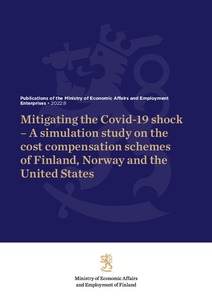Mitigating the Covid-19 shock – A simulation study on the cost compensation schemes of Finland, Norway and the United States
Ivaska, Juho (2022-02-22)
Ivaska, Juho
Ministry of Economic Affairs and Employment of Finland
22.02.2022
Julkaisusarja:
Publications of the Ministry of Economic Affairs and Employment 2022:8This publication is copyrighted. You may download, display and print it for Your own personal use. Commercial use is prohibited.
Julkaisun pysyvä osoite on
http://urn.fi/URN:ISBN:978-952-327-630-7Tiivistelmä
This Master's thesis compares the degree to which Finland's business cost support, Norway's kompensasjonsordning and the Paycheck Protection Program (PPP) of the US have been able to compensate for the impact of the coronavirus pandemic on the profitability, liquidity and solvency of companies. The comparison was carried out by simulating the shock to turnover caused by the coronavirus pandemic to Finnish companies under different cost support schemes, using Statistics Finland's financial statement data from 2019 to determine the baseline situation. The negative impacts of the pandemic were measured by the number of companies facing profitability and payment difficulties, and also with the help of mean variables that described the general state of business and industry.
The study showed that the Norwegian support system performed the best in all categories with the exception of one. In relation to its price, Finland's business cost support produced the highest impact on the average liquidity ratio in the simulation, but lagged behind the Norwegian model in other variables. The PPP was the most inefficient support scheme based on each variable.
As a conclusion, it can be stated that compensating for fixed costs plays an important role in supporting the companies most affected by the coronavirus. The Finnish business cost support can be considered to have fulfilled its purpose well. However, allowing both smaller and larger individual amounts of support could have made the support more effective.
The study showed that the Norwegian support system performed the best in all categories with the exception of one. In relation to its price, Finland's business cost support produced the highest impact on the average liquidity ratio in the simulation, but lagged behind the Norwegian model in other variables. The PPP was the most inefficient support scheme based on each variable.
As a conclusion, it can be stated that compensating for fixed costs plays an important role in supporting the companies most affected by the coronavirus. The Finnish business cost support can be considered to have fulfilled its purpose well. However, allowing both smaller and larger individual amounts of support could have made the support more effective.
